TP-Link Archer VR600 [Rev.2] Manual

User Guide
AC1600 Wireless Gigabit VDSL/ADSL Modem Router
Archer VR600
REV2.0.1 1910012217
Contents
About This Guide . . . . . . . . . . . . . . . . . . . . . . . . . . . . . . . . . . . . . . . . . . . . . . . . . . . . . 1
Chapter 1. Get to Know Your Modem Router . . . . . . . . . . . . . . . . . . . . . . . . . 2
1. 1. Product Overview . . . . . . . . . . . . . . . . . . . . . . . . . . . . . . . . . . . . . . . . . . . . . . . . . . . . . . . . . . . .3 1. 2. Physical Appearance . . . . . . . . . . . . . . . . . . . . . . . . . . . . . . . . . . . . . . . . . . . . . . . . . . . . . . . . .3 1. 2. 1. LED . . . . . . . . . . . . . . . . . . . . . . . . . . . . . . . . . . . . . . . . . . . . . . . . . . . . . . . . . . . . . . . .3 1. 2. 2. Ports and Antennas . . . . . . . . . . . . . . . . . . . . . . . . . . . . . . . . . . . . . . . . . . . . . . . .5 1. 2. 3. Buttons . . . . . . . . . . . . . . . . . . . . . . . . . . . . . . . . . . . . . . . . . . . . . . . . . . . . . . . . . . . .5
Chapter 2. Connect the Hardware . . . . . . . . . . . . . . . . . . . . . . . . . . . . . . . . . . . 7
2. 1. Position Your Modem Router . . . . . . . . . . . . . . . . . . . . . . . . . . . . . . . . . . . . . . . . . . . . . . . . .8 2. 2. Connect Your Modem Router . . . . . . . . . . . . . . . . . . . . . . . . . . . . . . . . . . . . . . . . . . . . . . . . .8
Chapter 3. Log In to Your Modem Router . . . . . . . . . . . . . . . . . . . . . . . . . . . . 10
Chapter 4. Set Up Internet Connections . . . . . . . . . . . . . . . . . . . . . . . . . . . . 12
4. 1. Use Quick Setup Wizard . . . . . . . . . . . . . . . . . . . . . . . . . . . . . . . . . . . . . . . . . . . . . . . . . . . . 13 4. 2. Manually Set Up an Internet Connection . . . . . . . . . . . . . . . . . . . . . . . . . . . . . . . . . . . . 13 4. 3. Test Internet Connectivity . . . . . . . . . . . . . . . . . . . . . . . . . . . . . . . . . . . . . . . . . . . . . . . . . . 14 4. 4. Set Up an IPv6 Connection . . . . . . . . . . . . . . . . . . . . . . . . . . . . . . . . . . . . . . . . . . . . . . . . . 15 4. 5. More Operation Modes. . . . . . . . . . . . . . . . . . . . . . . . . . . . . . . . . . . . . . . . . . . . . . . . . . . . . 16
4. 5. 1. Wireless Router Mode . . . . . . . . . . . . . . . . . . . . . . . . . . . . . . . . . . . . . . . . . . . . 16 4. 5. 2. 3G/4G Router Mode . . . . . . . . . . . . . . . . . . . . . . . . . . . . . . . . . . . . . . . . . . . . . . 17
Chapter 5. TP-Link Cloud Service . . . . . . . . . . . . . . . . . . . . . . . . . . . . . . . . . . . 18
5. 1. Register a TP-Link ID . . . . . . . . . . . . . . . . . . . . . . . . . . . . . . . . . . . . . . . . . . . . . . . . . . . . . . . 19 5. 2. Change Your TP-Link ID Information . . . . . . . . . . . . . . . . . . . . . . . . . . . . . . . . . . . . . . . . 19 5. 3. Manage the User TP-Link IDs . . . . . . . . . . . . . . . . . . . . . . . . . . . . . . . . . . . . . . . . . . . . . . . 20 5. 3. 1. Add an TP-Link ID to Manage the Router . . . . . . . . . . . . . . . . . . . . . . . . . . 21 5. 3. 2. Remove TP-Link ID(s) From Managing the Router . . . . . . . . . . . . . . . . . 21
5. 4. Manage the Router via TP-Link Tether App. . . . . . . . . . . . . . . . . . . . . . . . . . . . . . . . . . 22
Chapter 6. IPTV. . . . . . . . . . . . . . . . . . . . . . . . . . . . . . . . . . . . . . . . . . . . . . . . . . . . . 23
Chapter 7. Guest Network . . . . . . . . . . . . . . . . . . . . . . . . . . . . . . . . . . . . . . . . . . 25
7. 1. Create a Network for Guests . . . . . . . . . . . . . . . . . . . . . . . . . . . . . . . . . . . . . . . . . . . . . . . 26
7. 2. Customize Guest Network Options . . . . . . . . . . . . . . . . . . . . . . . . . . . . . . . . . . . . . . . . . 26
Chapter 8. USB Settings . . . . . . . . . . . . . . . . . . . . . . . . . . . . . . . . . . . . . . . . . . . . 28
8. 1. Access the USB Storage Device . . . . . . . . . . . . . . . . . . . . . . . . . . . . . . . . . . . . . . . . . . . . 29 8. 1. 1. Access the USB Device Locally. . . . . . . . . . . . . . . . . . . . . . . . . . . . . . . . . . . 29 8. 1. 2. Access the USB Device Remotely . . . . . . . . . . . . . . . . . . . . . . . . . . . . . . . . 31 8. 1. 3. Customize the Access Settings. . . . . . . . . . . . . . . . . . . . . . . . . . . . . . . . . . . 32
8. 2. Media Sharing. . . . . . . . . . . . . . . . . . . . . . . . . . . . . . . . . . . . . . . . . . . . . . . . . . . . . . . . . . . . . . 35 8. 3. Printer Sharing . . . . . . . . . . . . . . . . . . . . . . . . . . . . . . . . . . . . . . . . . . . . . . . . . . . . . . . . . . . . . 36 8. 4. 3G/4G Settings. . . . . . . . . . . . . . . . . . . . . . . . . . . . . . . . . . . . . . . . . . . . . . . . . . . . . . . . . . . . . 40 8. 4. 1. As a Backup Solution for Internet Access . . . . . . . . . . . . . . . . . . . . . . . . . 40 8. 4. 2. As the Only Way to Access the Internet. . . . . . . . . . . . . . . . . . . . . . . . . . . 41
Chapter 9. Parental Controls. . . . . . . . . . . . . . . . . . . . . . . . . . . . . . . . . . . . . . . . 43
Chapter 10.QoS . . . . . . . . . . . . . . . . . . . . . . . . . . . . . . . . . . . . . . . . . . . . . . . . . . . . . 47
10. 1. Prioritize Internet Traffic with QoS . . . . . . . . . . . . . . . . . . . . . . . . . . . . . . . . . . . . . . . . . . 48
10. 2. Update the Database. . . . . . . . . . . . . . . . . . . . . . . . . . . . . . . . . . . . . . . . . . . . . . . . . . . . . . . 49
Chapter 11.Network Security. . . . . . . . . . . . . . . . . . . . . . . . . . . . . . . . . . . . . . . . 51
11. 1. Firewall & DoS Protection. . . . . . . . . . . . . . . . . . . . . . . . . . . . . . . . . . . . . . . . . . . . . . . . . . . 52
11. 2. Service Filtering. . . . . . . . . . . . . . . . . . . . . . . . . . . . . . . . . . . . . . . . . . . . . . . . . . . . . . . . . . . . 53
11. 3. Access Control. . . . . . . . . . . . . . . . . . . . . . . . . . . . . . . . . . . . . . . . . . . . . . . . . . . . . . . . . . . . . 54
11. 4. IP & MAC Binding. . . . . . . . . . . . . . . . . . . . . . . . . . . . . . . . . . . . . . . . . . . . . . . . . . . . . . . . . . . 56
11. 5. IPv6 Firewall. . . . . . . . . . . . . . . . . . . . . . . . . . . . . . . . . . . . . . . . . . . . . . . . . . . . . . . . . . . . . . . . 57
Chapter 12.NAT Forwarding . . . . . . . . . . . . . . . . . . . . . . . . . . . . . . . . . . . . . . . . . 59
12. 1. Translate Address and Port by ALG . . . . . . . . . . . . . . . . . . . . . . . . . . . . . . . . . . . . . . . . . 60 12. 2. Share Local Resources over the Internet by Virtual Server . . . . . . . . . . . . . . . . . . 61 12. 3. Open Ports Dynamically by Port Triggering . . . . . . . . . . . . . . . . . . . . . . . . . . . . . . . . . 62 12. 4. Make Applications Free from Port Restriction by DMZ. . . . . . . . . . . . . . . . . . . . . . . 63 12. 5. Make Xbox Online Games Run Smoothly by UPnP. . . . . . . . . . . . . . . . . . . . . . . . . . . 64
Chapter 13.VPN Server. . . . . . . . . . . . . . . . . . . . . . . . . . . . . . . . . . . . . . . . . . . . . . 66
13. 1. Use OpenVPN to Access Your Home Network . . . . . . . . . . . . . . . . . . . . . . . . . . . . . . 67 13. 2. Use PPTP VPN to Access Your Home Network . . . . . . . . . . . . . . . . . . . . . . . . . . . . . . 68 13. 3. Use IPSec VPN to Access Your Home Network. . . . . . . . . . . . . . . . . . . . . . . . . . . . . . 72
Chapter 14.Specify Your Network Settings . . . . . . . . . . . . . . . . . . . . . . . . . . 76
14. 1. LAN Settings. . . . . . . . . . . . . . . . . . . . . . . . . . . . . . . . . . . . . . . . . . . . . . . . . . . . . . . . . . . . . . . 77
14. 1. 1. Change the LAN IP Address . . . . . . . . . . . . . . . . . . . . . . . . . . . . . . . . . . . . . . 77 14. 1. 2. Use the Modem Router as a DHCP Server . . . . . . . . . . . . . . . . . . . . . . . . 78 14. 1. 3. Reserve LAN IP Addresses . . . . . . . . . . . . . . . . . . . . . . . . . . . . . . . . . . . . . . . 79
14. 2. IPv6 LAN Settings. . . . . . . . . . . . . . . . . . . . . . . . . . . . . . . . . . . . . . . . . . . . . . . . . . . . . . . . . . 79 14. 2. 1. Configure the RADVD Address Type . . . . . . . . . . . . . . . . . . . . . . . . . . . . . . 80 14. 2. 2. Configure the DHCPv6 Server Address Type . . . . . . . . . . . . . . . . . . . . . 80
14. 3. Wireless Settings . . . . . . . . . . . . . . . . . . . . . . . . . . . . . . . . . . . . . . . . . . . . . . . . . . . . . . . . . . 81 14. 3. 1. Specify Basic Wireless Settings . . . . . . . . . . . . . . . . . . . . . . . . . . . . . . . . . . 81 14. 3. 2. Use WPS for Wireless Connection . . . . . . . . . . . . . . . . . . . . . . . . . . . . . . . . 83 14. 3. 3. Schedule Your Wireless Function . . . . . . . . . . . . . . . . . . . . . . . . . . . . . . . . . 85 14. 3. 4. View Wireless Information . . . . . . . . . . . . . . . . . . . . . . . . . . . . . . . . . . . . . . . . 86 14. 3. 5. Advanced Wireless Settings. . . . . . . . . . . . . . . . . . . . . . . . . . . . . . . . . . . . . . 87
14. 4. Set Up a Dynamic DNS Service Account . . . . . . . . . . . . . . . . . . . . . . . . . . . . . . . . . . . . 88 14. 5. Interface Grouping . . . . . . . . . . . . . . . . . . . . . . . . . . . . . . . . . . . . . . . . . . . . . . . . . . . . . . . . . 89 14. 6. Create Static Routes . . . . . . . . . . . . . . . . . . . . . . . . . . . . . . . . . . . . . . . . . . . . . . . . . . . . . . . 90 14. 7. Set Up the IPv6 Tunnel . . . . . . . . . . . . . . . . . . . . . . . . . . . . . . . . . . . . . . . . . . . . . . . . . . . . . 93 14. 7. 1. Use the Public IPv6 Tunnel Service-6to4. . . . . . . . . . . . . . . . . . . . . . . . . . 93 14. 7. 2. Specify the 6rd Tunnel with Parameters Provided by Your ISP . . . . . 94
Chapter 15.Administrate Your Network . . . . . . . . . . . . . . . . . . . . . . . . . . . . . . 95
15. 1. Set System Time . . . . . . . . . . . . . . . . . . . . . . . . . . . . . . . . . . . . . . . . . . . . . . . . . . . . . . . . . . . 96 15. 2. Control LEDs. . . . . . . . . . . . . . . . . . . . . . . . . . . . . . . . . . . . . . . . . . . . . . . . . . . . . . . . . . . . . . . 97 15. 3. Update the Firmware . . . . . . . . . . . . . . . . . . . . . . . . . . . . . . . . . . . . . . . . . . . . . . . . . . . . . . . 97 15. 3. 1. Online Upgrade . . . . . . . . . . . . . . . . . . . . . . . . . . . . . . . . . . . . . . . . . . . . . . . . . . 98 15. 3. 2. Local Upgrade . . . . . . . . . . . . . . . . . . . . . . . . . . . . . . . . . . . . . . . . . . . . . . . . . . . 98
15. 4. Back up and Restore Configuration Settings . . . . . . . . . . . . . . . . . . . . . . . . . . . . . . . . 99 15. 5. Change the Administrator Account . . . . . . . . . . . . . . . . . . . . . . . . . . . . . . . . . . . . . . . . 100 15. 6. Local Management. . . . . . . . . . . . . . . . . . . . . . . . . . . . . . . . . . . . . . . . . . . . . . . . . . . . . . . . 100 15. 7. Remote Management . . . . . . . . . . . . . . . . . . . . . . . . . . . . . . . . . . . . . . . . . . . . . . . . . . . . . 101 15. 8. System Log . . . . . . . . . . . . . . . . . . . . . . . . . . . . . . . . . . . . . . . . . . . . . . . . . . . . . . . . . . . . . . . 102 15. 9. Monitor the Internet Traffic Statistics . . . . . . . . . . . . . . . . . . . . . . . . . . . . . . . . . . . . . . 104 15. 10. CWMP Settings . . . . . . . . . . . . . . . . . . . . . . . . . . . . . . . . . . . . . . . . . . . . . . . . . . . . . . . . . . . 105 15. 11. SNMP Settings . . . . . . . . . . . . . . . . . . . . . . . . . . . . . . . . . . . . . . . . . . . . . . . . . . . . . . . . . . . . 107
Appendix: Troubleshooting . . . . . . . . . . . . . . . . . . . . . . . . . . . . . . . . . . . . . . . . .109

About This Guide
This guide is a complement to Quick Installation Guide. The Quick Installation Guide provides instructions for quick internet setup, while this guide contains details of each function and demonstrates how to configure them in typical scenarios.
When using this guide, please notice that features of the router may vary slightly depending on the model and software version you have, and on your location, language, and internet service provider. All images, parameters and descriptions documented in this guide are used for demonstration only.
Conventions
In this guide, the following conventions are used:
Convention |
Description |
Underline |
Hyperlinks are in teal and underlined. You can click to redirect to a website |
|
or a specific section. |
Teal |
Key information appears in teal, including management page text such as |
|
menus, items, buttons and so on. |
The menu structures to show the path to load the corresponding page. For
>example, Advanced > Wireless > MAC Filtering means the MAC Filtering function page is under the Wireless menu that is located in the Advanced tab.
|
|
Note: |
Ignoring this type of note might result in a malfunction or damage to the |
|
|
|
device. |
||
|
|
|||
|
|
|
Tips: |
Indicates important information that helps you make better use of your |
|
|
|
device. |
|
|
|
|
||
Symbols on |
• click to edit the corresponding entry. |
|||
• click to delete the corresponding entry. |
||||
the web page |
• click to enable or disable the corresponding entry. |
|||
|
|
|
|
• click to view more information about items on the page. |
More Info
•The latest firmware and management app are available from the Download Center at http://www.tp-link.com/support.
•The Quick Installation Guide (QIG) can be found where you find this guide or inside the product packaging.
•Specifications can be found on the product page at http://www.tp-link.com.
•A Technical Support Forum is provided for you to discuss our products at http://forum.tp-link.com.
•Our Technical Support contact information can be found at the Contact Technical Support page at http://www.tp-link.com/support.
1

Chapter 1
Get to Know Your Modem Router
This chapter introduces the modem router by detailing its main features and appearance. It contains the following sections:
•Product Overview
•Physical Appearance
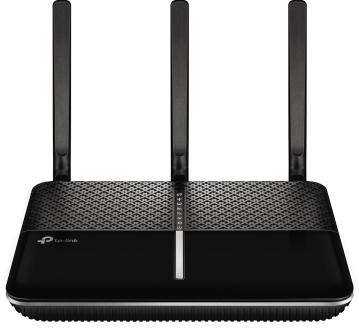
Chapter 1 |
Get to Know Your Modem Router |
1. 1. Product Overview
TP-Link’s modem router is a combined wired/wireless network connection device with wireless router and DSL modem capabilities.
With DSL and LAN/WAN ports, the modem router is compatible with DSL connections and fiber/cable access.
Ethernet ports and adjustable antennas enable the modem router to provide wired and wireless access for multiple computers and mobile devices.
With an array of additional features, the modem router is the perfect hub for your home or business network.
1. 2. Physical Appearance
1. 2. 1. LED
The modem router’s LEDs are located on the top panel. You can check the modem router’s working status by following the LED Explanation table.
3

Chapter 1 Get to Know Your Modem Router
|
|
|
LED Explanation |
|
|
|
|
|
Name |
Status |
Indication |
|
|
On |
The system has started up successfully. |
|
|
Flashing |
The system is starting up or firmware is being upgraded. |
|
Power |
Do not disconnect or power off your modem router. |
|
|
|
||
|
|
Off |
Power is off. Please ensure that the power adapter is |
|
|
connected correctly. |
|
|
|
|
|
|
|
On |
DSL synchronization is complete. |
|
DSL |
Flashing |
DSL synchronization is in progress. |
|
Off |
DSL synchronization failed. Please refer to 1 for |
|
|
|
||
|
|
troubleshooting. |
|
|
|
|
|
|
|
On |
Internet service is available. |
|
Internet |
Off |
Internet connection is incorrect or the modem router |
|
|
is operating in Bridge mode. Please refer to 3 for |
|
|
|
|
troubleshooting. |
Wireless 2.4GHz |
On |
The wireless 2.4GHz/5GHz band is working properly. |
|
/ |
Off |
The wireless 2.4GHz/5GHz band is disabled. |
|
Wireless 5GHz |
|||
|
|
On |
At least one LAN port is connected to a powered-on |
|
LAN |
device. |
|
|
|
||
|
|
Off |
No LAN port is connected to a powered-on device. |
|
|
On |
The USB device is ready to use. |
|
USB |
Flashing |
The USB device is being identified. |
|
|
Off |
No USB device is plugged into the USB port. |
|
|
On |
A wireless device has been successfully added to the |
|
|
network by WPS. |
|
|
|
|
|
|
|
|
WPS handshaking is in process and will continue for |
|
WPS |
Flashing |
about 2 minutes. Please press the WPS button on other |
|
wireless devices that you want to add to the network |
||
|
|
|
while the LED is flashing. |
|
|
Off |
A wireless device has failed to be added to the network |
|
|
by WPS. |
|
|
|
|
|
 Note:
Note:
1.If the DSL LED is off, please check your internet connection. Refer to Connect Your Modem Router for more information about how to connect to the internet correctly. If you have already made a successful connection, please contact your ISP to make sure your internet service is available now.
2.If the Internet LED is orange, please check your internet configuration. You may need to check this information with your ISP and make sure everything has been input correctly.
3.If the Internet LED is off, please check your DSL LED first. If your DSL LED is also off, please refer to 1. If your DSL LED is ON, reconnect your modem router correctly by referring to related guide.
4.Turn on or off the LEDs by pressing the LED On/Off button on the top panel.
4
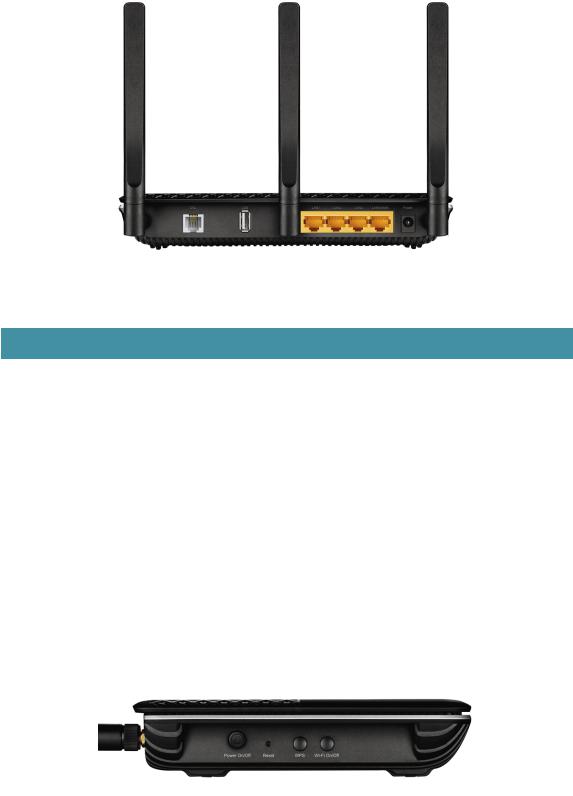
Chapter 1 |
Get to Know Your Modem Router |
1. 2. 2. Ports and Antennas
The modem router’s back panel shows the connection ports, buttons and antennas. Refer to the following for detailed instructions.
Item |
Description |
|
DSL |
For connecting the modem router to the internet. Connect the port to |
|
the splitter or directly connect the port to the phone jack via a phone |
||
|
cable. For details, please refer to Connect Your Modem Router. |
|
USB |
For connecting to a USB storage device or a USB printer. |
|
LAN1, LAN2, LAN3, |
For connecting the modem router to your PC or other Ethernet network |
|
devices. In wireless router mode, the LAN4/WAN port is used for |
||
LAN4/WAN |
||
connecting to a Cable/FTTH/VDSL/ADSL device. |
||
|
||
Power |
For connecting the modem router to a power socket via the provided |
|
power adapter. |
||
|
||
Antennas |
Used for wireless data transmission. Position them upright for the best |
|
performance. |
||
|
1. 2. 3. Buttons
5
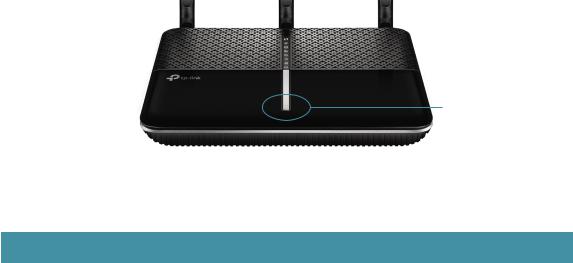
Chapter 1 |
Get to Know Your Modem Router |
LED On/Off
The modem router’s side panel shows the buttons. Refer to the following for detailed instructions.
Item |
Description |
|
Power On/Off |
The switch for the power. Press it to power on or off the modem router. |
|
Reset |
Press and hold down for 8 seconds to reset the modem router into |
|
factory default settings. |
||
|
||
WPS |
Press to start a WPS synchronization. |
|
Wi-Fi On/Off |
Press for 1 second to turn both 2.4GHz and 5GHz Wi-Fi on or off. |
|
LED On/Off |
Press to turn the LEDs on or off. LED button is on the front panel, at |
|
the end of all LEDs. |
||
|
6

Chapter 2
Connect the Hardware
This chapter contains the following sections:
•Position Your Modem Router
•Connect Your Modem Router
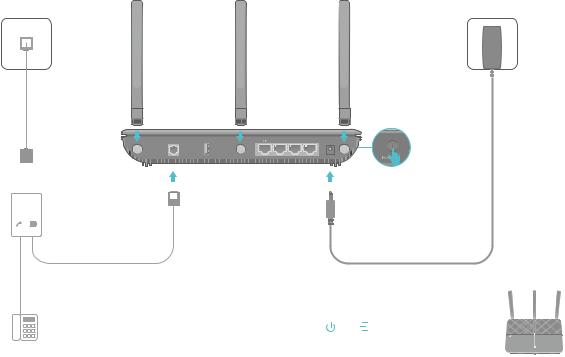
Chapter 2 |
Connect the Hardware |
2. 1. Position Your Modem Router
With the modem router, you can access your network from anywhere within the wireless network coverage. However, the wireless signal strength and coverage varies depending on the environment your modem router is in. Obstacles may limit the range of the wireless signal, for example, concrete structures, thick walls.
For best Wi-Fi performance, and to keep your network secure:
•Do not locate the modem router in a place where it will be exposed to moisture or excessive heat.
•Keep the product away from strong electromagnetic radiation and devices that emit electromagnetic waves.
•Place the modem router in a location where it can be connected to the various devices as well as to a power source.
•Make sure the cables and power cord are safely placed out of the way so they do not create a tripping hazard.
 Tips: The modem router can be placed on a shelf or desktop.
Tips: The modem router can be placed on a shelf or desktop.
2. 2. Connect Your Modem Router
Follow the steps below to connect your modem router.
1.Connect the DSL line and power adapter. The electrical outlet shall be installed near the device and shall be easily accessible.
Phone Jack
 2
2
LINE
1 Power Adapter
Attachtheantennas.
DSL |
USB |
LAN2 |
LAN3 |
LAN4/WAN |
Power |
3 |
Modem Router |
Push in to turn on |
|
||
|
|
4 the modem router. |
PHONE MODEM
DSL Splitter
Phone Cable
If you don’t need the phone service, just directly connect
the modem router to the phone jack with the provided phone cable, then follow steps 3 and 4 to complete the
Phone (Optional) hardware connection.
5 Verify that the following LEDs turn stable before continuing with the configuration.
Power On |
DSL On |
Note: The DSL LED takes about 1 to 2 minutes to stabilize.
8
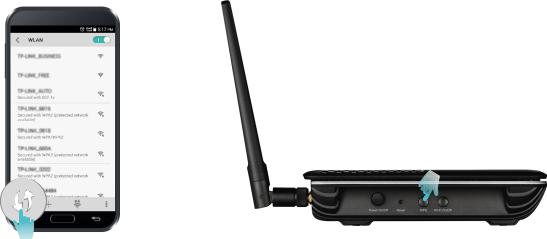
Chapter 2 |
Connect the Hardware |
2. Connect your computer to the modem router.
Method 1: Wired
Connect your computer’s Ethernet port to the LAN port on the modem router via the Ethernet cable.
Method 2: Wirelessly
Use the default SSID (Wireless Network Name) and Wireless Password printed on the included Wi-Fi Info Card or on the product label of the modem router to connect wirelessly.
Method 3: Use the WPS button
Wireless devices that support WPS, including Android phones, tablets, most USB network cards, can be connected to your router through this method. (WPS is not supported by iOS devices.)
 Note:
Note:
The WPS function cannot be configured if the wireless function of the router is disabled. Also, the WPS function will be disabled if your wireless encryption is WEP. Please make sure the wireless function is enabled and is configured with the appropriate encryption before configuring the WPS.
1 ) |
Tap the WPS icon on the device’s screen. |
2 ) |
Immediately press the WPS button on your modem router. |
3 ) |
The WPS LED flashes for about two minutes during the WPS process. |
4 ) |
When the WPS LED stabilizes and remains on, the client device has successfully |
|
connected to the modem router. |
9

Chapter 3
Log In to Your Modem Router
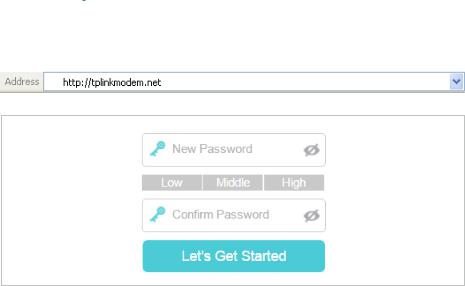
Chapter 3 |
Log In to Your Modem Router |
With the web management page, it is easy to configure and manage the modem router. The web management page can be used on any Windows, Macintosh or UNIX OS with a Web browser, such as Microsoft Internet Explorer, Mozilla Firefox or Apple Safari.
Follow the steps below to log in to your modem router.
1.If the TCP/IP Protocol on your computer is set to the static (fixed) IP address, you need to change its settings to obtain an IP address automatically. Refer to Appendix: Troubleshooting to configure your computer.
2.Launch a web browser and go to http://tplinkmodem.net or http://192.168.1.1. Create a strong password and click Let’s Get Started to log in.
 Note:
Note:
If you have registered a TP-Link ID and bind your cloud router to it, the login password you created here should be ineffective. Please log in to the cloud router using your TP-Link ID.
11

Chapter 4
Set Up Internet
Connections
This chapter introduces how to connect your modem router to the internet. The modem router is equipped with a web-based Quick Setup wizard. It has many ISP information built in, automates many of the steps and verifies that those steps have been successfully completed. Furthermore, you can also set up an IPv6 connection if your ISP provides IPv6 service.
This chapter includes the following sections:
•Use Quick Setup Wizard
•Manually Set Up an Internet Connection
•Test Internet Connectivity
•Set Up an IPv6 Connection
•More Operation Modes
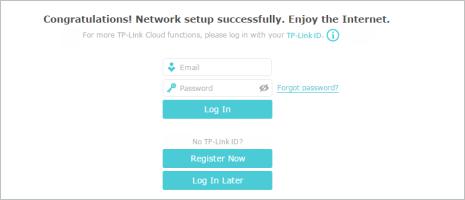
Chapter 4 |
Set Up Internet Connections |
4. 1. Use Quick Setup Wizard
1.Visit http://tplinkmodem.net, and log in with your TP-Link ID or the password you set for the router.
2.Click Quick Setup on the top of the page. Then follow the step-by-step instructions to connect your router to the internet.
3.To enjoy a more complete service from TP-Link (remote management, TP-Link DDNS, etc.), log in with your TP-Link ID or click Register Now to get one. Then follow the instructions to bind the modem router to your TP-Link ID.
 Note:
Note:
1.To learn more about the TP-Link Cloud service, please refer to the TP-Link Cloud section.
2.If you do not want to register a TP-Link ID for now, you may click Log In Later to proceed.
3.If you have changed the preset wireless network name (SSID) and wireless password during the Quick Setup process, all your wireless devices must use the new SSID and password to connect to the router.
4.2. Manually Set Up an Internet Connection
1.Visit http://tplinkmodem.net, and log in with your TP-Link ID or the password you set for the router.
2.Go to Basic > Internet page. Select your ISP, and related information will be automatically filled in. For some ISPs, you may need to manually specify some information provided. If you can’t find your ISP in the ISP List, select Other and then enter the information provided by your ISP.
13
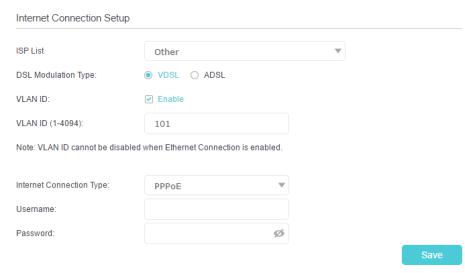
Chapter 4 |
Set Up Internet Connections |
||
|
|
|
|
|
|
|
|
3.Click Save to make the settings effective, and you can refer to Test Internet Connectivity to test the internet connection.
 Tips: You can view and edit all internet connection settings on the Advanced > Network > Internet page.
Tips: You can view and edit all internet connection settings on the Advanced > Network > Internet page.
4. 3. Test Internet Connectivity
After manually setting up the internet connection, you need to test the internet connectivity. The modem router provides a diagnostic tool to help you locate the source of any problems.
1.Visit http://tplinkmodem.net, and log in with your TP-Link ID or the password you set for the router.
2.Go to Advanced > System Tools > Diagnostics page.
14
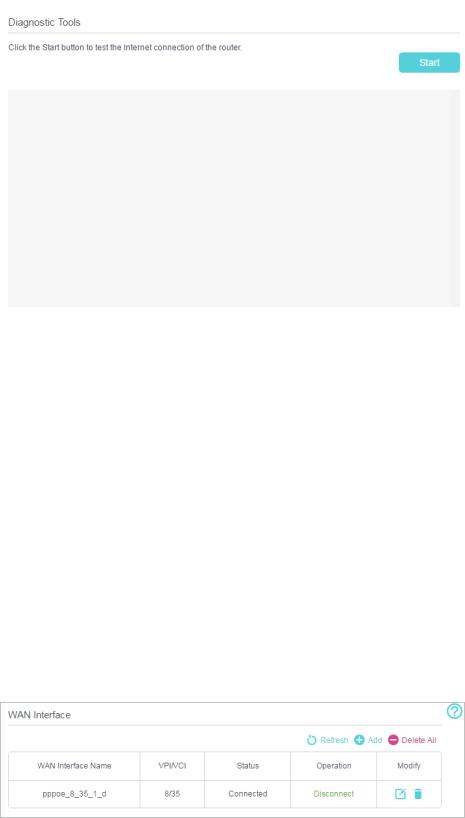
Chapter 4 |
Set Up Internet Connections |
||
|
|
|
|
|
|
|
|
3.Click Start to test the internet connectivity and you will see the test result in the gray box.
4.4. Set Up an IPv6 Connection
If your ISP has provided a DSL line that supports IPv6 connection as well as some detailed IPv6 parameters, you can manually set up an IPv6 connection.
If your ISP provides an IPv4-only connection or IPv6 tunnel service, permit IPv6 connection by referring to Set Up the IPv6 Tunnel.
Follow the steps below to set up an IPv6 connection:
1.Make sure you have set up an IPv4 connection either manually or by using the Quick Setup wizard before setting up an IPv6 connection.
2.Visit http://tplinkmodem.net, and log in with your TP-Link ID or the password you set for the router.
3.Go to Advanced > Network > Internet page.
4.Select your WAN Interface Name (Status should be Connected) and click the  (Edit) icon.
(Edit) icon.
15

Chapter 4 |
Set Up Internet Connections |
5.Scroll down the page, enable IPv6, and configure the IPv6 parameters.
•Addressing Type: Consult your ISP for the addressing type (DHCPv6 or SLAAC). SLAAC is the most commonly used addressing type.
•IPv6 Gateway: Keep the default setting as Current Connection.
 Note: If your ISP has provided the IPv6 address, click Advanced to reveal more settings. Check to use IPv6 specified by ISP and enter the parameters provided by your ISP.
Note: If your ISP has provided the IPv6 address, click Advanced to reveal more settings. Check to use IPv6 specified by ISP and enter the parameters provided by your ISP.
6.Click OK to make the settings effective. Now IPv6 service is available for your network.
4. 5. More Operation Modes
The modem router supports two more operation modes: Wireless Router mode and 3G/4G Router mode. You can change the mode according to your needs.
4. 5. 1. Wireless Router Mode
If you already have a modem or your internet comes via an Ethernet jack on the wall, you can set up the modem router as a regular wireless router to share the internet.
1.Find the WAN port (labeled as LAN4/WAN) on the modem router, and connect it to your existing modem or the Ethernet jack on the wall. Then connect the power adapter and turn on the modem router. If you connect an existing modem, reboot it to get the modem router connected to the internet.
2.Connect your computer to the modem router. For details, refer to Connect Your Modem Router.
3.Visit http://tplinkmodem.net, and log in with your TP-Link ID or the password you set for the router.
4.Go to Advanced > Operation Mode, select the Wireless Router Mode, and click Save. The modem router will reboot.
16
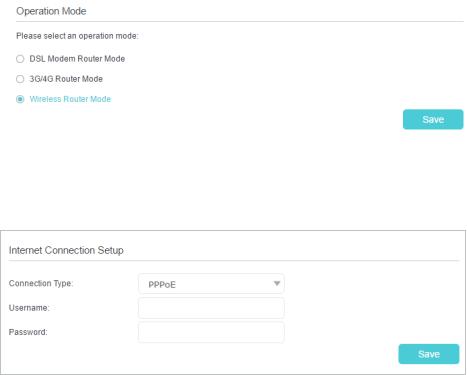
Chapter 4 |
Set Up Internet Connections |
||
|
|
|
|
|
|
|
|
5.Go to Basic > Internet, select the Connection Type, and enter the information provided by your ISP.
6. Click Save to make the settings effective.
 Tips:
Tips:
1.You can view and edit all internet connections on Advanced > Network > Internet page.
2.In the Wireless Router Mode, you can also permit IPv6 connection by setting up an IPv6 connection or the IPv6 tunnel just as in the DSL Modem Router Mode. For details, refer to Set Up an IPv6 Connection and Set Up the IPv6 Tunnel.
4. 5. 2. 3G/4G Router Mode
The modem router can be used as a 3G/4G wireless router if you have a 3G/4G USB modem. There are two ways to use your 3G/4G network:
• As a backup solution for internet access
Use this way if you have set up an internet connection successfully and want to use the 3G/4G network as a backup network. Your modem router will be directly connected to the 3G/4G network when the original network service fails. For detailed instructions, refer to As a Backup Solution for Internet Access.
• As the only way to access the internet
Use this way if wired internet access is not available and you can only use the 3G/4G network to access the internet. For detailed instructions, refer to As the Only Way to Access the Internet.
 Tips:
Tips:
In the 3G/4G Router Mode, you can also permit IPv6 connection by setting up the IPv6 tunnel just as in the DSL Modem Router Mode. For details, refer to Set Up the IPv6 Tunnel.
17

Chapter 5
TP-Link Cloud Service
TP-Link Cloud service provides a better way to manage your cloud devices. Log in to your router with a TP-Link ID, and you can easily monitor and manage your home network when you are out and about via the Tether app on your smartphone or tablet. To ensure that your router stays new and gets better over time, the TP-Link Cloud will notify you when an important firmware upgrade is available. Surely you can also manage multiple TP-Link Cloud devices with a single TP-Link ID.
This chapter introduces how to register a new TP-Link ID, bind or unbind TP-Link IDs to manage your router, and the Tether app with which you can manage your home network no matter where you may find yourself.
It contains the following sections:
•Register a TP-Link ID
•Change Your TP-Link ID Information
•Manage the User TP-Link IDs
•Manage the Router via TP-Link Tether App
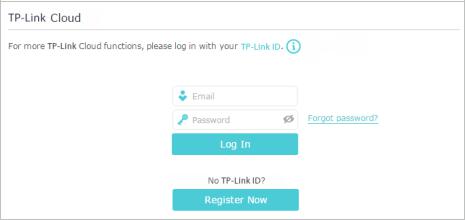
Chapter 5 |
TP-Link Cloud Service |
5. 1. Register a TP-Link ID
If you have skipped the registration during the Quick Setup process, you can
1.Visit http://tplinkmodem.net, and log in with the password you set for the router.
2.Go to Basic > TP-Link Cloud.
3.Click Register Now and follow the instructions to register a TP-Link ID.
4.After activating your TP-Link ID, come back to the TP-Link Cloud page to log in. The first-time login TP-Link ID will be bound automatically to your cloud router as an Admin.
 Note:
Note:
•To learn more about the Admin and User TP-Link ID, refer to Manage the User TP-Link IDs.
•Once the router is bound to your TP-Link ID, you need to log in to the router with the TP-Link ID.
•You can register another TP-Link ID via the Tether APP. Please refer to Manage the Router via TP-Link Tether App to install the app and register a new one
•If you want to unbind the admin TP-Link ID from your router, please go to Basic > TP-Link Cloud, click Unbind in the Device Information section.
5. 2. Change Your TP-Link ID Information
Follow the steps below to change your email address and password of your TP-Link ID as needed.
1.Visit http://tplinkmodem.net, and log in with your TP-Link ID.
2.Go to Basic > TP-Link Cloud, and focus on the Account Information section.
¾¾ Change your email address
1.Click  behind the Email.
behind the Email.
2.Enter the password of your TP-Link ID, then the new email address. And click Save.
19

Chapter 5 |
|
TP-Link Cloud Service |
|
|
|
|
|
|
¾¾ Change your password
1.Click  behind the Password.
behind the Password.
2.Enter the current password, then a new password twice. And click Save.
5. 3. Manage the User TP-Link IDs
The first-time login TP-Link ID will be bound automatically to your router as an Admin account. An admin account can add or remove other TP-Link IDs to the same router as Users. Admin account and User accounts both can monitor and manage the router locally or remotely, except that user accounts cannot:
•Reset the router to its factory default settings from the web management page or the Tether app.
20
![TP-Link Archer VR600 [Rev.2] Manual TP-Link Archer VR600 [Rev.2] Manual](/html/04/0477/0477c84e3ed19f085a12adcee96fb36b243c29635b2f5a5112e74c6d610a05d4/htmlconvd-4D8NGc25x1.jpg)
Chapter 5 |
TP-Link Cloud Service |
• Add/remove other TP-Link IDs to/from the router.
5. 3. 1. Add an TP-Link ID to Manage the Router
1.Visit http://tplinkmodem.net, and log in with your TP-Link ID.
2.Go to Basic > TP-Link Cloud, and focus on the Bound Accounts section.
3.Click  , enter another TP-Link ID as needed and click Save.
, enter another TP-Link ID as needed and click Save.
 Note:
Note:
If you need another TP-Link ID, please refer to Manage the Router via TP-Link Tether App to install the app and register a new one.
4. The new TP-Link ID will be displayed in the Bound Accounts table as a User.
5. 3. 2. Remove TP-Link ID(s) From Managing the Router
1.Visit http://tplinkmodem.net, and log in with your TP-Link ID.
2.Go to Basic > TP-Link Cloud, and focus on the Bound Accounts section.
3.Check the box(es) of the TP-Link ID(s) you want to remove and click Unbind.
21

Chapter 5 |
TP-Link Cloud Service |
5. 4. Manage the Router via TP-Link Tether App
The Tether app runs on iOS and Android devices like smartphones and tablets.
1.Open the Apple App Store or Google Play and search the key word TP-Link Tether or simply scan the QR code to download and install the app.
OR
2.Connect your device to the router’s wireless network.
3.Launch the Tether app, select the model of your router and log in with your TP-Link ID or the password you set for the router.
4.Manage your router as needed.
22

Chapter 6
IPTV
IPTV is the abbreviation of Internet Protocol Television. The service can only be delivered through the Internet, and our modem router provides a specific LAN port for IPTV.
By automatically separating IPTV from Internet surfing, you can enjoy a high quality of video streaming and fast browsing speeds at the same time.
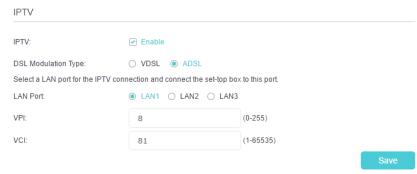
Chapter 6 |
|
IPTV |
I want to: |
Configure the modem router to enable Internet Protocol |
|
|
Television (IPTV) Services. |
|
|
For example, I already bought IPTV service, but this service |
|
|
can only be delivered through the Internet. Therefore, I need to |
|
|
configure my modem router first. |
|
How can I |
1. |
Visit http://tplinkmodem.net, and log in with your TP-Link ID |
do that? |
|
or the password you set for the router. |
|
2. |
Go to Advanced > IPTV to open the configuration page. |
|
|
|
|
3. |
Click Enable IPTV to enable this function. |
|
4. |
Select your DSL modulation type. |
|
5. |
Specify a LAN port for IPTV connection and connect the set- |
|
|
top box to this port. |
|
6. |
If you select VDSL modulation type, check to enable VLAN |
|
|
and set the VLAN ID. If you select ADSL, fill in PVC parameters |
|
|
(VPI and VCI). VLAN ID and PVC parameters are all provided |
|
|
by your IPTV service provider. |
|
7. |
Click Save to make the settings effective. |
Done! |
Modem router configuration is complete! You may still need to |
|
|
configure settings on your set-top box before enjoying your |
|
|
IPTV service. |
|
24

Chapter 7
Guest Network
This function allows you to provide Wi-Fi access for guests without disclosing your main network. When you have guests in your house, apartment, or workplace, you can create a guest network for them. In addition, you can assign network authorities and bandwidth for guests to ensure network security, privacy, and fluency.
•Create a Network for Guests
•Customize Guest Network Options
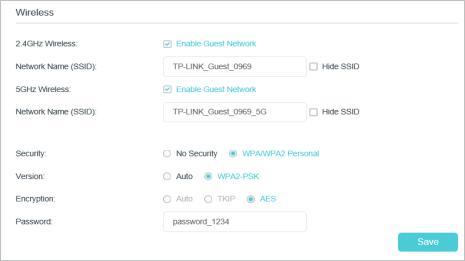
Chapter 7 |
Guest Network |
7. 1. Create a Network for Guests
1.Visit http://tplinkmodem.net, and log in with your TP-Link ID or the password you set for the router.
2.Go to Advanced > Guest Network. Locate the Wireless Settings section.
3.Create 2.4GHz and 5GHz guest network according to your needs.
1 ) Enable 2.4GHz Wireless or 5GHz Wireless or enable both according to your needs.
2 ) Set an easy-to-identify SSID. Don‘t select Hide SSID unless you want your guests and other people to manually input this SSID for Wi-Fi access.
3 ) Set Security to WPA/WPA2 Personal, keep the default Version and Encryption values, and set an easy-to-remember password. 2.4GHz and 5GHz guest networks share the same password.
4.Click Save. Now your guests can access your guest network using the SSID and password you set!
 Tips:
Tips:
To view guest network information, go to Advanced > Status and find the Guest Network section.
7. 2. Customize Guest Network Options
1.Visit http://tplinkmodem.net, and log in with your TP-Link ID or the password you set for the router.
2.Go to Advanced > Guest Network.
26
